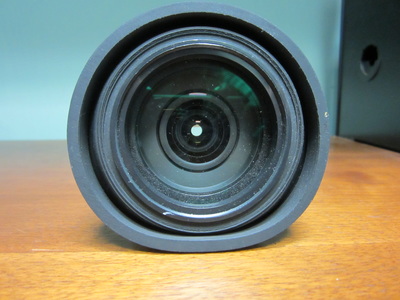Defining compositional freedom the 18-270mm Di-II VC's incredible 15x zoom range provides a 35mm picture angle equivalency of 28mm to 419mm, with image fidelity assured by advanced optical design featuring LD glass and aspherical optics, working in concert to render crisp, colorful and faithful images.
Tamron Di-II lenses are engineered expressly for digital SLR cameras* with image sensors commonly referred to as APS-C, measuring approximately 24mm x 16mm. Rendering an ideal image circle for APS-C sensors, Di-II lenses are also include properties to optimize digital imaging performance.
Tamron's Unique State-of-the-Art In-Lens Image Stabilization System
Handheld camera shake is the leading cause of blurry and unsharp pictures. Several leading companies now make lenses with built-in optical image-stabilization systems that sense the amplitude and direction of the shake and compensate by moving optical groups within the lens. Tamron's exclusive new Vibration Compensation (VC) system that's built into the Tamron AF28-300mm F/3.5-6.3 XR Di VC LD Aspherical (IF) Macro and the Tamron AF18-270mm F/3.5-6.3 Di-II VC LD Aspherical (IF) Macro lenses performs a similar function, but it executes it much more effectively due to its innovative breakthrough design.
PZD (Piezo Drive) piezoelectric AF motor
Piezoelectric drive replaces traveling wave energy with more efficient standing wave energy for higher AF performance with less weight and bulk. A vital contributor to compactness, PZD focuses quickly and precisely, assuring sharper results in demanding conditions with speed that captures spontaneous moments crisply--moments that might otherwise be lost to image softness. PZD is exceptionally quiet, making it ideal for nature, live performance shooting, golf and other conditions that demand quiet operation.
Low Dispersion (LD) Glass for Greater Lens Sharpness
Low dispersion (LD) glass elements in a lens help reduce chromatic aberration; the tendency of light of different colors to come to different points of focus at the image plane. Chromatic aberration reduces the sharpness of an image, but glass with an extremely lowdispersion index, has less of a tendency to separate (defract) a ray of light into a rainbow of colors. This characteristic allows the lens designer to effectively compensate for chromatic aberration at the center of the field (on axis), a particular problem at long focal lengths (the telephoto end of the zoom range), and for lateral chromatic aberration (towards the edges of the field) that often occurs at short focal lengths (the wide-angle end of the zoom range.)
Hybrid Aspherical Elements Provide the Ultimate in Image Quality and Compactness
Tamron uses several hybrid aspherical lens elements in many lenses bearing the Aspherical designation. These innovative optics allow us to achieve the ultimate in image quality, and at the same time produce lenses that offer remarkable zoom ranges in extraordinarily compact packages. By perfecting theses cutting-edge advances for series production, Tamron has advanced the state of optical design, and virtually eliminated spherical aberration and image distortion from the high-power-zoom series.Through the effective application of Hybrid Aspherical Technology, one lens elemen tcan take the place of multiple elements without compromising performance. This is what allows us to produce remarkably compact long-range lenses that deliver a uniformly high level of image quality at all focal lengths and apertures.
nternal Focusing (IF) System
Internal focusing (IF) provides numerous practical benefits to photographers including a non-rotating front filter ring that facilitates the positioning of polarizing and graduated filters, and more predictable handling because the lens length does not change during focusing. Even more important, Tamron's Internal Focusing (IF) system provides a much closer minimum focusing distance (MFD) throughout its entire focusing range. In addition, IF improves optical performance by minimizing illumination loss at the corners of the image field, and helps to suppress other aberrations that become more troublesome at different focusing positions.
Zoom Lock (ZL) Feature
Another original Tamron mechanical engineering concept is the Zoom Lock (ZL), a simple convenience feature that prevents undesired extension of the lens barrel when carrying the camera/lens unit on a neck strap.




